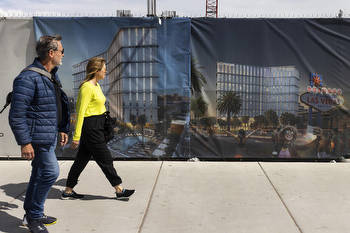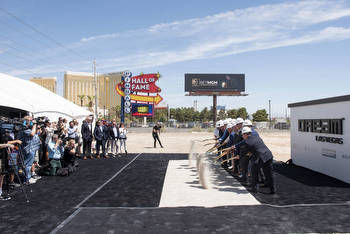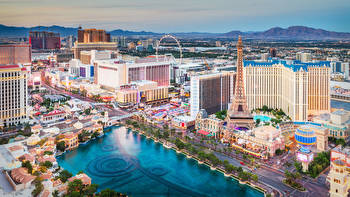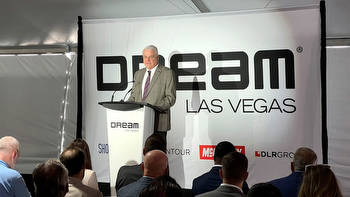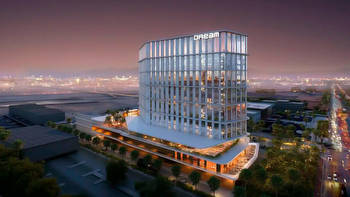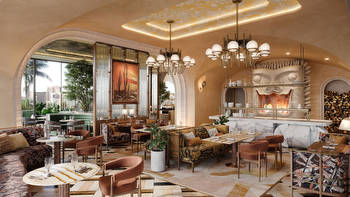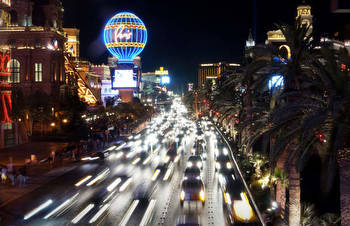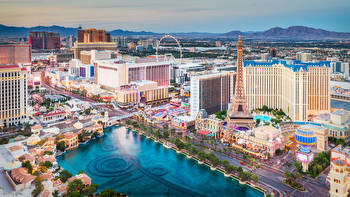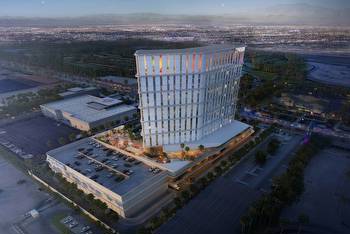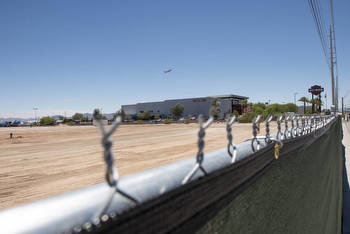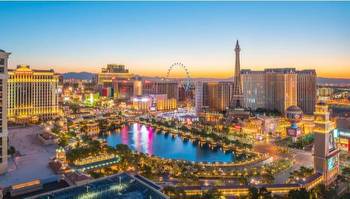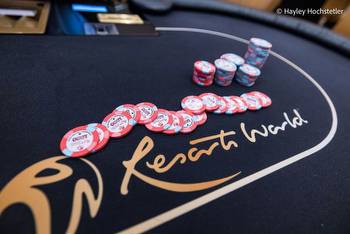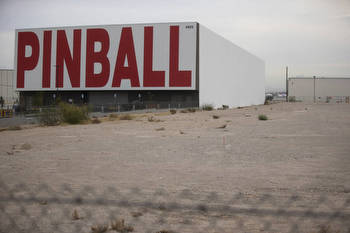Dream Las Vegas finds next door neighbor built a little too close
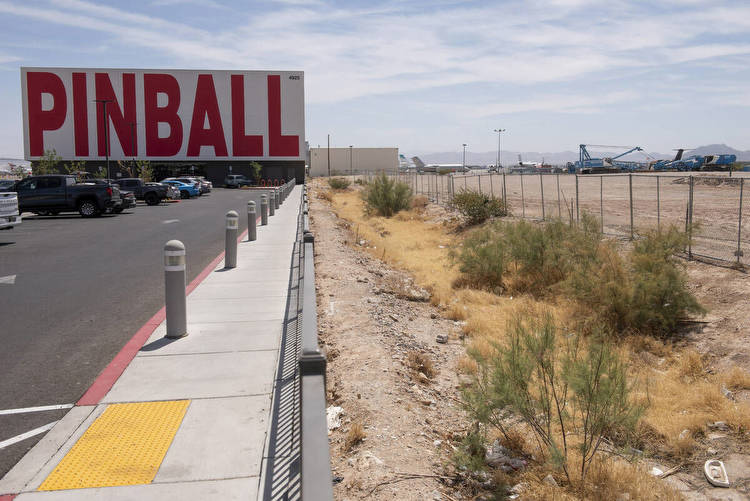
Once Dream Las Vegas opens at the south edge of the Strip, the upscale hotel would offer a new spot for people to gamble, eat, network and party.
It will also be a little closer than expected to its next-door neighbor.
The Pinball Hall of Fame encroached by “at least eight feet” on Dream’s property, according to a lawsuit the hotel developers filed last fall in Clark County District Court. The complaint called the encroachment an “unlawful occupation” of Dream’s property and said it prevented a drainage outlet, “as originally designed and engineered, from being constructed.”
A “likely” surveying error by a contractor indicated the arcade “owned more property than it initially purchased,” Pinball’s attorneys wrote in a filing in the now-settled case.
Dream, a $550 million project by Southern California firms Shopoff Realty Investments and Contour, held its ceremonial groundbreaking in July. The 531-room casino-resort on Las Vegas Boulevard just south of Russell Road is slated to open in early 2025 and would offer a smaller, boutique-style experience in a corridor dominated by massive hotel-casinos with thousands of rooms apiece.
Before last month’s groundbreaking and the Pinball lawsuit, the project had already faced a number of hurdles.
Developers unveiled plans for the resort a month before the coronavirus outbreak upended daily life in Southern Nevada.
They later made a series of design changes after facing such concerns as possible illegal drone flying and bombs hidden in garbage trucks, due to Dream’s location next to Las Vegas’ airport.
And, court records show, they discovered the neighboring pinball arcade was a little too close.
‘New one for me’
Both sides say the property line issue is settled and there are no hard feelings, with Shopoff Realty founder Bill Shopoff describing the arcade’s operators as “innocent bystanders.”
He also said the encroachment would not impact Dream’s hotel tower, as it was discovered early enough to make adjustments before construction of the project started.
“That’s the time to catch it,” he said.
As part of the settlement, Shopoff said his group conveyed a small amount of land and received money from the surveyor. He declined to disclose the amount of the payment.
Shopoff said he has seen minor encroachments over the years, sometimes by inches, but never a building constructed over its property line.
“It was a new one for me,” said Shopoff, who has worked in real estate for more than 40 years.
Las Vegas Pinball Collectors Club president Tim Arnold, whose nonprofit owns the arcade, said the “whole thing could have gone south and come off the rails at any point,” but instead there was compromise and negotiation.
“Everyone stood up and did what they had to do,” said Arnold, who noted if he “had to pick a bad guy on this, it’s nobody.”
Encroaching on airport land
Arnold hired Las Vegas-based Lochsa Engineering in 2018 to provide land surveying services at Pinball’s project site on Las Vegas Boulevard. Lochsa brought in an affiliate to survey the property, according to court filings this spring by Pinball’s attorneys.
Dream’s developers notified the arcade of the encroachment last year, and after Pinball looked into the claims, “it became apparent that Lochsa Engineering and/or its affiliates likely erred when it surveyed the property by indicating that Pinball owned more property than it initially purchased,” Pinball’s attorneys wrote in the filing.
Arnold told the Review-Journal the settlement payment was covered by Lochsa’s insurance company.
Lochsa was founded in 1995, according to its website. It boasts a range of clients such as government agencies, architectural firms and building contractors, as well as a lengthy project portfolio spanning numerous industries including aviation, education, hospitality, industrial and multifamily.
The firm did not return calls seeking comment.
Clark County government’s online mapping site — similar to Google Maps but with real estate parcel boundaries and other information — shows a portion of the Pinball project on Dream’s land.
It also appears to show a small portion of the Pinball project on adjacent land owned by the Clark County Department of Aviation.
Arnold declined to comment on that.
“Yes, we are aware that a portion of the Pinball Hall of Fame encroaches on DOA-owned land,” Department of Aviation spokesman Joe Rajchel told the Review-Journal in an email Thursday, adding it “seems to be a matter of a mere 345 square feet.”
The Pinball property borders what appears to be a small service road in a private aviation area at Harry Reid International Airport.
“As this has had no impact on airport operations, we are working with them on a mutually beneficial solution,” Rajchel said.
‘Zero feet’
While operating from a facility on Tropicana Avenue near UNLV, Arnold’s nonprofit bought a narrow parcel of land on Las Vegas Boulevard in 2018 to develop a bigger building that could hold hundreds more arcade games.
Project plans called for a one-story, 50-foot-tall building spanning 26,880 square feet, according to county documents, which showed it would be built 386 feet from its west property line along Las Vegas Boulevard, 29 feet from its east property line at the airport and “zero feet from the north and south property lines.”
Clark County commissioners approved the project plans in spring 2019. The arcade, which inside feels like an aircraft hangar lined with rows of pinball machines, debuted in spring 2021.
Meanwhile, Shopoff and Contour teamed up to buy a roughly 5-acre plot of land immediately south of the Pinball site in February 2020 for the Dream project. County commissioners approved their project plans in October 2021.
The next month, Dream’s developers sued Las Vegas Pinball Collectors Club, alleging the arcade encroached onto their property.
Nancy Amundsen, director of Clark County’s Department of Comprehensive Planning, told the Review-Journal that the arcade was built in an area that had no required setbacks from the sides or the rear because it’s not adjacent to residential property and because of the resort corridor’s zoning.
Amundsen, who started her career as a county employee in 2006, also indicated she hadn’t heard of a similar property line dispute in her time with the county.
“This is the first time I’ve heard one since I’ve been here,” she said.









